This summary presents the findings of a global survey on the future of knowledge work in cities. Conducted between November 2020 and January 2021, the survey invited urban thought leaders and practitioners from around the world to share their perspectives on what could and should happen to knowledge work in cities over the next decade.
The survey is part of the Urban Age Debates: Cities in the 2020s outreach programme organised by LSE Cities and the Alfred Herrhausen Gesellschaft. The results of the survey informed the first Debate’s theme, Socialising Remote Work: Will changing patterns in knowledge work reduce or amplify the human need to meet in cities?
1. THE BIG PICTURE
A total of 905 urban thinkers and practitioners from 73 countries shared their views and opinions for this Urban Age Debates Survey. Three groups of respondents with similar sentiments towards the future of knowledge work in cities were identified: the concerned, the reassured, and the ambivalent. Knowledge work is a broad term that describes professions that produce unique knowledge with an emphasis on non-routine problem-solving; for example: programmers, physicians, architects, engineers, lawyers, and academics.[1]
The first group, the concerned, believe that knowledge workers will spend more time working from home or local offices, but fear that this shift might reduce business opportunities and considerably reduce agglomeration advantages. They are also more likely to strongly agree that the private automobile will dominate city streets once again. Overall, this group sees a post-COVID future based at or near home, in which knowledge workers will spend little time working in pre-COVID offices.
The second group, the reassured, agree with the concerned that working from home or closer to home would reduce business opportunities and agglomeration advantages and that a shift to remote work would also spark the domination of city streets by private automobile. However, unlike the concerned, this group does not believe that knowledge workers will spend more time working from local offices, and instead anticipate a return to pre-COVID offices as more likely.
The third cluster, the ambivalent, gather around the middle and believe that knowledge workers will spend an equal amount of time working from local offices, in-person, and using a hybrid model. They are also neutral on the effects of working from home or closer to home with regards to agglomeration advantages and business opportunities. Alongside this group’s ambivalence, these respondents are split on how much they believe in-person interaction impacts creativity in knowledge work.
Across all three groups, respondents’ sentiments are relatively negative about the impact of abandoning the pre-COVID office, in particular regarding business opportunities, agglomeration advantages, creativity in knowledge work and the risk of furthering social divisions and spatial inequities. This may indicate that a complete and enthusiastic shift to exclusively remote knowledge work may be problematic and is unlikely to occur. While one could expect that respondents would disagree along demographic and professional divisions, interestingly, all three clusters included respondents of various demographics. No demographic feature (age, country, profession, or gender) could accurately predict being a part of any of the three groups of respondents.
2. SPECIFIC FINDINGS
From an economic development perspective, cities are commonly seen as sites of agglomeration where the concentration of economic activity, spill-over effects and large labour pools enable high levels of productivity, collaboration and innovation.[2] As decades of empirical work has shown, this has been particularly the case for knowledge work in cities.[3]
Since early 2020, the COVID-19 pandemic and related policy responses have repeatedly forced offices to close, city centres to empty and knowledge workers in cities around the world to operate from home. Moving into the 2020s, this changing paradigm of work raises important questions: How will these experimental changes impact knowledge work patterns in the future? What should happen to knowledge work in cities considering wider social, economic and environmental factors?
2.1 Future Scenarios for Knowledge Work
While some trends indicate a return to office-based work patterns with the inclusion of hybrid models (which will be accelerated by access to a vaccine),[4] some commentators welcome the greater personal flexibility and access to the global talent pool afforded by virtual technologies.[5] This opens up many issues that cities will have to face, including the impacts of the dramatic shift in working conditions, how sites of knowledge work will adapt, and how cities can maintain their economic and cultural vibrancy without negatively impacting productivity, connectivity and personal freedom.
This first section presents survey insights linked to possible scenarios that could affect knowledge work in the next decade. When asked which of two macro-scenarios for the future of knowledge work they consider more likely to occur (Figure 1), a majority of respondents (61%) believe that a major restructuring of knowledge work locations is more likely than a return to pre-crisis, business-as-usual trends (39%).
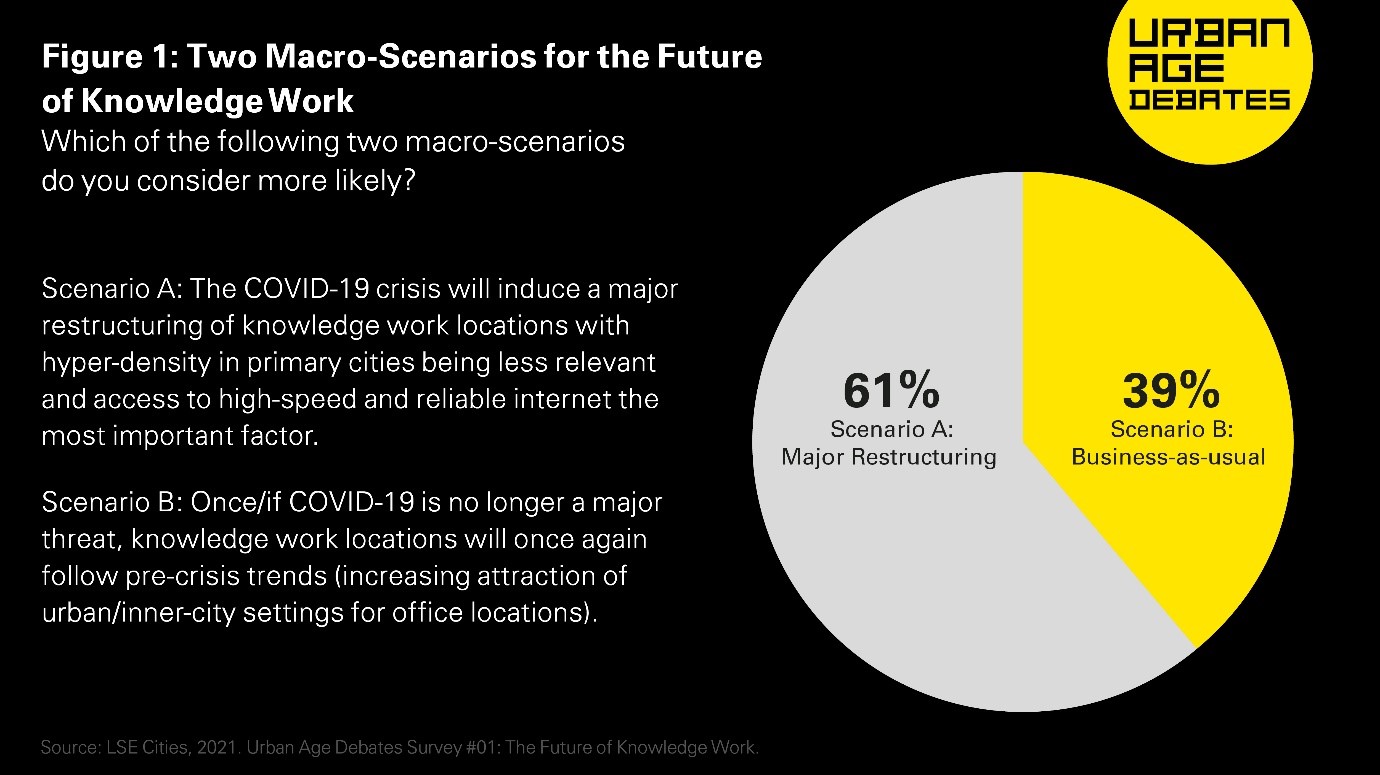
This speculation then leads to the question of what new functionalities will emerge for pre-2020 office locations and where knowledge work will occur in the future (Figure 2). Most survey respondents (70%) agreed that it is likely that micro-clustering, such as the 15-minute city model, will become more common, and 59 per cent consider it likely that inner cities will emerge as hubs for intensive socialisation. Just over half of the respondents (54%) agreed that it was likely that commuter towns for knowledge workers will bounce back, and 52 per cent judge that radical virtualisation where online interaction dominates is a likely outcome.
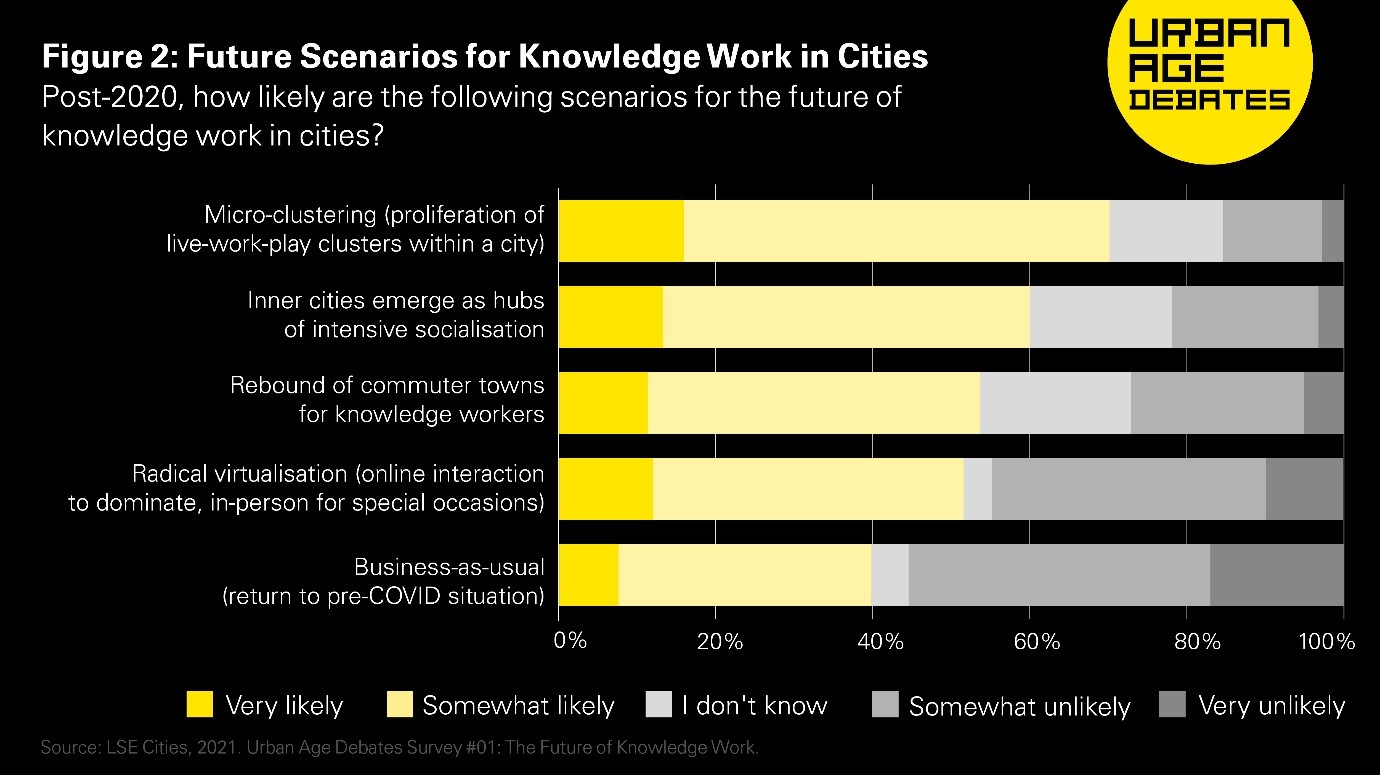
Interestingly, respondents predict that there will be a close to even time split for collaborative and team-based knowledge work conducted online (36%), in-person (31%) and using a hybrid model (33%). This would represent a significant shift, as before March 2020, only around 5 per cent of knowledge workers were primarily working from home which would have included some collaborative work.[6] Based on these speculations it could be assumed that knowledge workers will increase their days working remotely and initiate a shift to online collaboration, which will endure over the next decade.

2.2 Assessing Knowledge Work in Cities
This second section discusses survey findings based on the respondents’ assessment and informed opinions on the current and future nature of knowledge work in cities over the next decade.
Regarding the effect of remote work on business opportunities and agglomeration advantages, opinions were split and relatively indifferent (Figure 4). A majority of respondents, however, agreed that conducting knowledge from home considerably reduces both business opportunities and livelihoods (53%), and agglomeration advantages (63%). In both cases, only a small group of respondents have no opinion. From this, it seems that slightly more respondents worry about the effects of knowledge work from or closer to home on agglomeration advantages than on business opportunities.
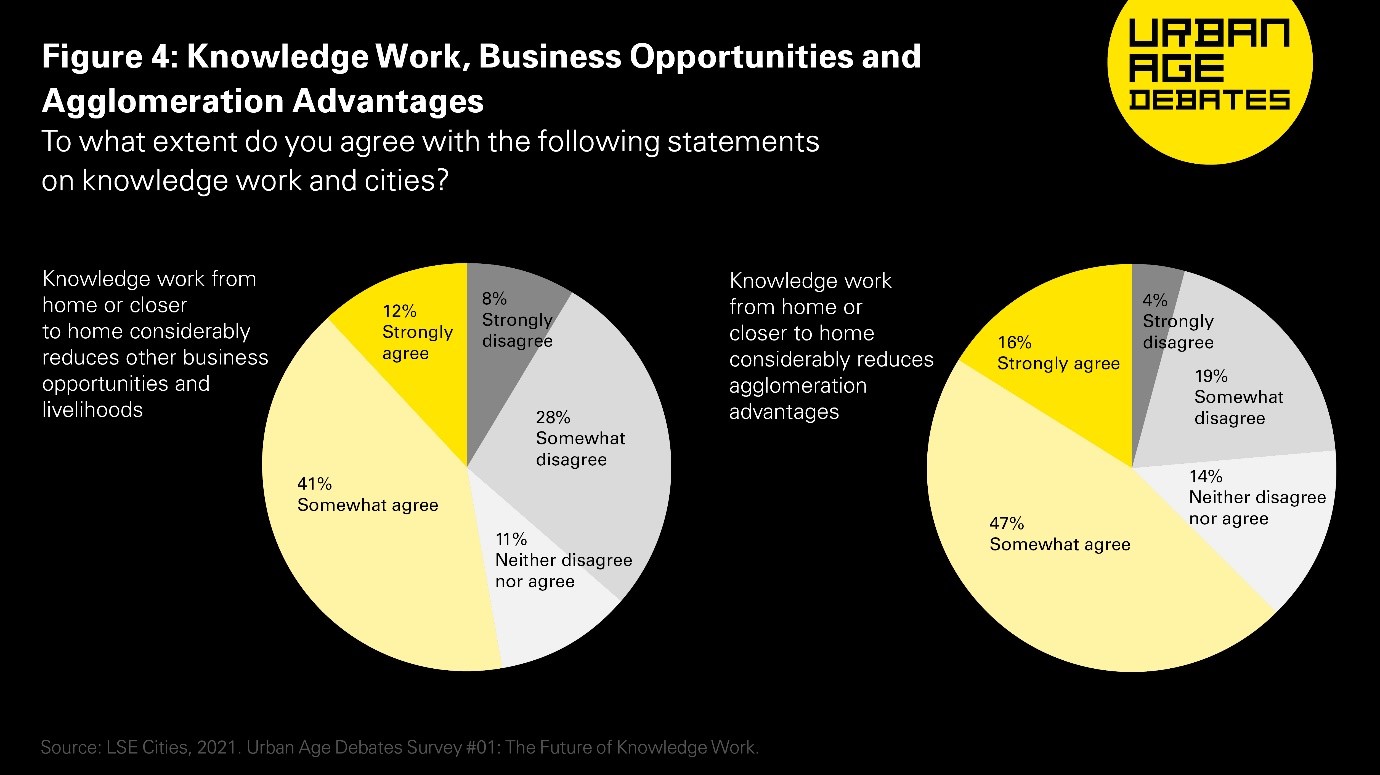
As advantages for knowledge work in urban settings were universally accepted and thus centrally underpinned urban policy making pre-2020, it is paramount to consider various subcomponents of this urban dividend and reflect on their continued or changing importance (Figure 5). Survey respondents rank developing networks of trust and collaboration as the most critical advantage of urban settings for future knowledge work, followed by informal access to ideas and knowledge as the second most, and access to business and personal amenities and services as the third most critical advantage. Increased productivity and access to large labour pools were ranked second to last and last, respectively. These results indicate that the value and advantages of urban settings for the future of knowledge work is primarily social in nature, as networks of trust and collaboration as well as informal knowledge exchange heavily rely on in-person social interactions.
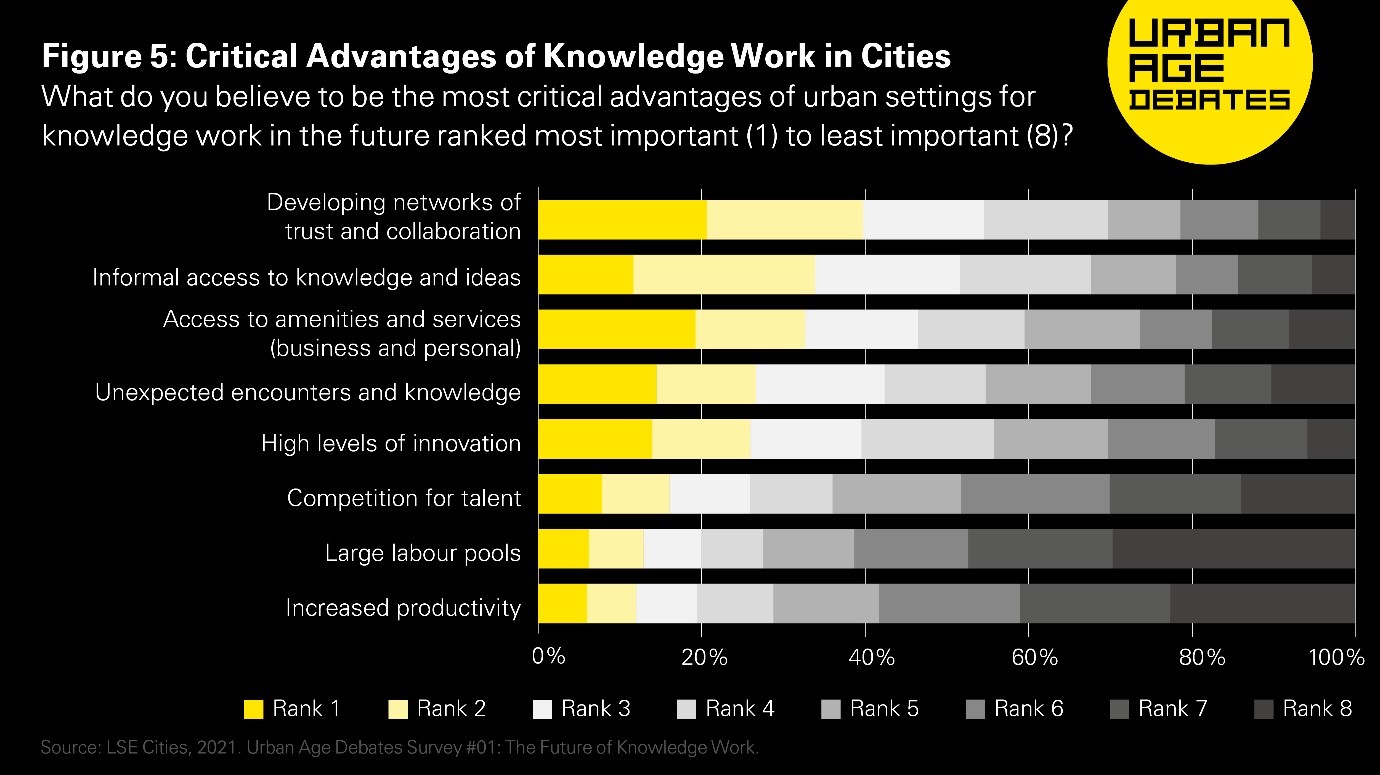
2.3 An Agenda for the Next Decade of Knowledge Work
This last section reviews survey insights on a more normative agenda for knowledge work in cities over the coming decade.
Here, the survey initially asked how often knowledge workers should interact in-person for a variety of functions in order to identify the most valued use of in-person interactions. Respondents answered that advancing team creativity and problem-solving, as well as building trust amongst team members should occur in-person more often than other functions such as socialising with team members, improving productivity and skill-building and professional development. This may indicate that the future use of offices and in-person interactions should prioritise advancing creativity, problem-solving and trust-building, over others that can occur in-person less often or, through virtualisation, not in-person at all.
When asked directly about various options of what should happen to knowledge work in urban settings (Figure 6), respondents ranked first that knowledge work closer to home should be promoted, and second that physical office space should be as flexible as possible. Interestingly, respondents ranked last that working from home should become the primary location of knowledge work. This indicates that a comprehensive shift to working from home is not desirable and when considering work dynamics and other societal factors, knowledge workers should spend at least some time outside their homes. The prioritisation of either more decentralised knowledge work or the re-establishment of existing locations appears to be less clear among the respondents.
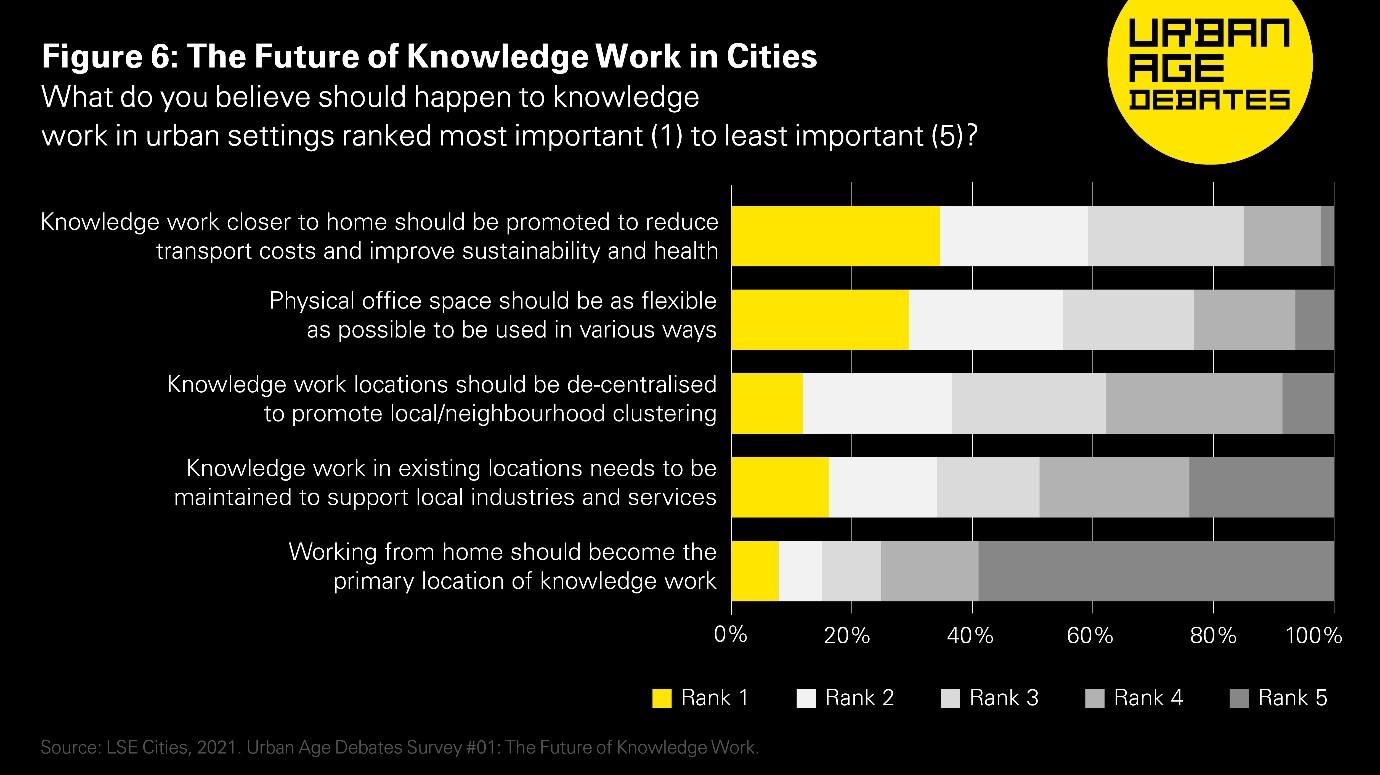
In relation to the future location of knowledge work, respondents agreed that urban leaders must act swiftly to sufficiently adapt to the dramatic changes occurring in inner cities. When asked to list actions that urban leaders must take, responses grouped around four actions:
- Ensure safe, efficient and accessible public transportation systems and infrastructure;
- Improve and maintain high quality, safe and accessible public and green spaces;
- Promote flexible office spaces and flexibility in work arrangements and structures, including working from home;
- Upgrade information and communication tenchnology (ICT) infrastructure and capabilities, and increase digitalisation.
Despite this, one respondent cautioned urban leaders, “Don’t overreact! Don’t push digitalisation too hard or just for the sake of it.” Other respondents chimed in stating, “The geography of work will become more nuanced; it’s not either city or home, but both. This is already happening,” and that urban leaders must “Consider the cost and benefits of maintaining centralised urban central business districts, and decide whether they want to actively support these or let them die.” Other respondents were more straight-forward with their responses, such as this respondent pushing urban leaders to “Prioritise urban design for walking, then cycling, then public transportation – no questions asked, no debate.”
3. CONCLUSION
This survey overview has shown that no consensus exists between urban thought leaders and practitioners on the future of knowledge work in cities. Instead, our analysis showed that three main groups with varying sentiments emerged: the concerned, the reassured, and the ambivalent. Despite these three different groups, respondents across all groups felt relatively negative about the impact of abandoning the pre-COVID office, suggesting that a hybrid model with an increased number of days working remotely with some days in the office may be most appropriate. The results of this survey suggest that much remains to be seen in how knowledge workers, and in turn the location of knowledge work, will react to the dramatic changes of 2020 in the long term. With this in mind, urban policymakers have an important role in shaping the post-2020 nature and location of knowledge work, as one respondent summarised, “Urban leaders must consider the cost and benefits of maintaining centralised urban central business districts, and decide whether they want to actively support these or let them die.”
[1] Reinhardt, W., Schmidt, B., Sloep, P. & Drachsler, H., 2011. Knowledge Worker Roles and Actions—Results of Two Empirical Studies. Knowledge and Process Management, 18(3), pp. 150-174.[2] Glaeser, E., 2010. Introduction. In: E. Glaeser, ed. Agglomeration Economics. Chicago: University of Chicago Press, pp. 1-14.[3] Tallman, S., Jenkins, M., Henry, N. & Pinch, S., 2004. Knowledge, Clusters, and Competitive Advantage. Academy of Management Review, 29(2), pp. 258-271.[4] JLL Global Research, 2020. Reimagining Human Experience: How to embrace the new work-life priorities and expectations of a liquid workforce , Chicago: Jones Lang Lasalle.[5] Frankiewicz, B. & Tomas, C.-P., 2020. The Post-Pandemic Rules of Talent Management. [Online]
Available at: https://hbr.org/2020/10/the-post-pandemic-rules-of-talent-management [Accessed 23 February 2021].[6] Milasi, S., González-Vázquez, I. & Fernández-Macías, E., 2020. Telework in the EU before and after the COVID-19: where we were,, Brussels: European Commission. This summary of the Urban Age Debate Survey #01 ‘The Future of Knowledge Work in Cities’ is intended as a basis for discussion. While every effort has been made to ensure the accuracy of the material presented, the authors and/or LSE Cities will not be liable for any loss or damage incurred through the use of its findings. Prepared by: Noah Powers, Sara Luxmoore and Philipp Rode
Advice and support: Ricky Burdett and Emily CruzGraphic Design: AtelierWorks, www.atelierworks.co.uk Special thanks to all survey respondents. Published for the Urban Age Programme by LSE Cities, London School of Economics and Political Science, 2021.
APPENDIX: METHODOLOGY
This survey was conducted online and respondents were contacted across the Urban Age Programme’s international network via direct emails and social media. The survey garnered 905 responses during the period of November 2020 and January 2021 of which 800 were complete and included in the analysis of each question. The highest number of respondents worked in the fields of Urbanism and Architecture. Responses were recorded from 73 countries, and the highest number of respondents were from the United Kingdom, Germany and the United States. Respondents were evenly spread across age groups and gender, with the vast majority falling between 30 and 60 years old.
Figure 7: Survey Demographics
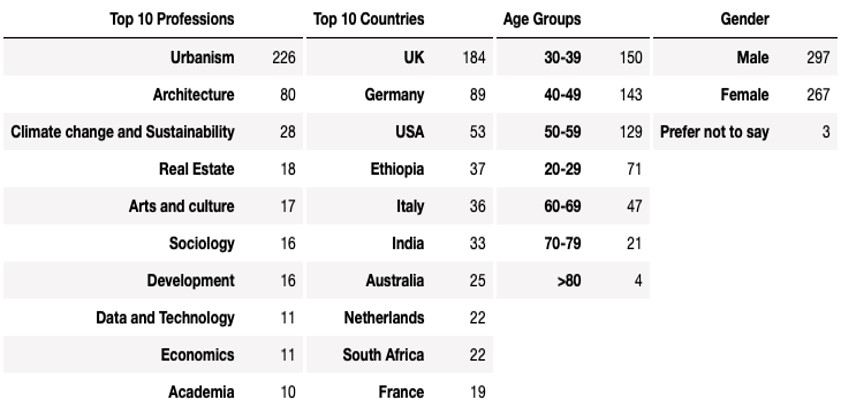
Due to the unprecedented shift to remote working and the circumstances of the COVID-19 pandemic, it was challenging to accurately hypothesise how survey respondents would feel towards the wider effects of remote work on knowledge work in cities. As such, the survey was specifically targeted towards scoping broader subjective views and attitudes rather than definitive answers based on evidence. The questions focused on respondents’ speculation on how knowledge work in cities could be affected over the next decade. It also surveys what should be done according to the respondents’ opinions.
After gathering the question responses from the survey, the data was cleaned and converted to integer values. The next step used a dimensionality reduction method to compress the data to conduct further analysis. Dimensionality reduction methods reduce the dimensions in a dataset (given by the number of variables) which then allows for the data to be plotted on two or three axes. Reducing dimensions was completed by using semi-supervised or unsupervised methods to identify patterns among the variables. Three dimensionality reduction methods were tested: Principal Component Analysis, t-Distributed Stochastic Neighbour Embedding (TSNE), and Locally Linear Embedding. Locally Linear Embedding was used as this method best revealed underlying structures in the dataset.
The Locally Linear Embedding analysis revealed two groups of questions whose responses were highly correlated (named Component 1 and Component 2). A cluster analysis was then performed, which analyses the dataset for groups or ‘clusters’ of respondents who answered questions similarly, based on these two groups of questions (Component 1 and Component 2).
These two components were fitted to the k-means algorithm in order to determine the number of clusters that the analysis would be capped at. This process reveals the highest number of clusters after which point each increase in the number of clusters does not significantly increase the level of inertia (the sum of squared distances to the nearest cluster centre) or variance, in the data. In sum, this process shows the ideal number of clusters that should be included in the cluster analysis. This point is shown in the graph below, at the ‘elbow’ point where the line stops moving downwards and starts to stabilise towards zero inertia.
Figure 8: K-means Graph
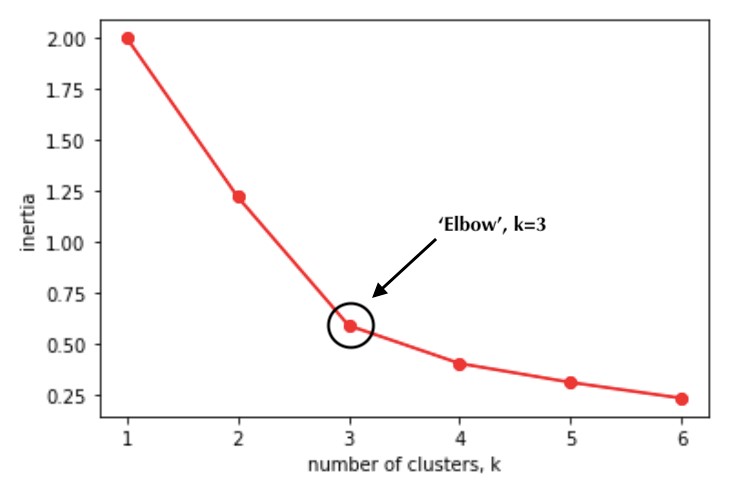
After this, the cluster analysis was performed on the condition that the data would be grouped in three clusters. These clusters were based on respondents unique response profiles (how they answered the questions), and they were named accordingly: the reassured, the concerned, and the ambivalent.